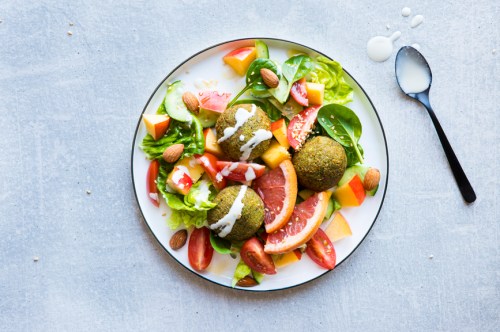3 Easy Ways To Increase Your Iron Absorption From Food, According to a Top Functional Medicine Doctor
Here, Mark Hyman, MD shares three easy ways to increase your iron absorption from foods, especially if you're a plant-based eater.

Iron deficiency is extremely common amongst many Americans—in fact, it has been reported that about 10 million people aren’t getting enough iron, and half of those people suffer from anemia. We’ve all heard about the importance of consuming iron-rich foods, but it’s essential to understand how this mineral works to keep our bodies healthy and functioning efficiently.
Experts in This Article
functional medicine doctor and author of Young Forever
Top functional medicine physician and New York Times bestselling author Mark Hyman, MD is well-known for his straightforward approach to educating about nutrition and overall health. Dr. Hyman goes way beyond giving healthy eating tips. Instead, he breaks down why it’s so important to consider certain foods as medicine, and shares how those foods can help support our organs, immune system, muscles, cognitive functioning, and overall health in the present and as we get older.
Iron is a mineral that benefits the body in a myriad of ways. In fact, iron works as a “transporter” to help deliver oxygen from our lungs to our tissues. “The oxygen we breathe into our lungs hitches a ride from hemoglobin, the iron-rich protein inside our red blood cells,” Dr. Hyman explains. “Hemoglobin and iron ‘carpool’ together, picking up oxygen and dropping it off at its destination—tissue—before scooping up carbon dioxide on the way back to the lungs to be exhaled.” Another interesting fact that Dr. Hyman shares is that our bodies can recycle and reuse iron from old blood cells, so it can be stored in case our levels ever decrease too much.
Iron deficiency is also common amongst those who menstruate, as large amounts of iron is depleted during menstruation. “[People who identify as] women in their reproductive years require significantly more iron than [people who identify as] men,” Dr. Hyman recently shared on Instagram. “Pregnant women also require more iron to support increased blood volume and the nutrient requirements for a growing baby.”
Another important caveat: Iron is traditionally found in animal products, like meat and seafood, making it potentially tricky for vegetarians and vegans to get enough of it. A small 2017 study comparing 30 vegetarian women with 30 non-vegetarian women found that 60 percent of the plant-based dieters were mildly anemic, compared to the 46 percent of non-vegetarian women who were normal or mildly anemic.
So, what’s the key to maintaining iron levels, especially if you follow a mostly plant-based diet? Dr. Hyman suggests eating non-heme iron-rich foods as often as possible. “Heme iron comes from animal products such as meat and seafood,” Amy Gorin, MS, RDN, previously told Well+Good. It’s found in the blood proteins and hemoglobin of these animals—the same places you find it in humans. Non-heme iron comes from plant-based foods, such as beans, fortified cereal, nuts, and vegetables,” she says. Some of the top sources of non-heme include vegetables high in iron like spinach and broccoli, along with other plant-based foods like chickpeas, mushrooms, lentils, and black beans.
In addition to adding more of the above foods to your meals, here are three easy ways to increase iron absorption, according to Dr. Hyman.
Dr. Hyman’s tips for increasing your iron absorption from foods
1. Eat iron-rich plant foods with vitamin C
According to Dr. Hyman, eating foods containing vitamin C will help the body better absorb non-heme iron—and chances are, you already have plenty of fruits and vegetables rich in vitamin C already in your fridge. Brussels sprouts, bell peppers, spinach, potatoes, and winter squash are all great options to enjoy with grains and legumes for a super iron- and vitamin C-packed meal. If you need some delicious recipe inspiration, cook up a lentil stew with roasted tomatoes or whip a side dish with bulgur, chopped broccoli, and a squeeze of lemon.
You can also try making these delicious vegan lentil and walnut tacos, which are packed with plant-based protein, iron, and vitamin C:
2. Try fruits with non-heme iron
Dr. Hyman says that the fructose, which is what makes fruit naturally sweet, helps increase iron absorption. “Adding some pomegranate seeds or blood orange to your spinach salad will increase non-heme iron absorption—and it will taste good, too!” he says.
These gluten-free blueberry muffins are another delicious way to get an extra serving of fruit into your day:
3. Limit pairing iron-rich foods with foods contain calcium
Foods that are rich in calcium could inhibit iron absorption, Dr. Hyman says. You definitely shouldn’t avoid calcium entirely, but if you’re looking to increase your iron intake, try to avoid pairing foods rich in calcium with foods that are rich in non-heme iron. “This could mean not adding cheese to your eggs or goat cheese to your salad,” Dr. Hyman says.
Oh hi! You look like someone who loves free workouts, discounts for cutting-edge wellness brands, and exclusive Well+Good content. Sign up for Well+, our online community of wellness insiders, and unlock your rewards instantly.
Sign Up for Our Daily Newsletter
Get all the latest in wellness, trends, food, fitness, beauty, and more delivered right to your inbox.
Got it, you've been added to our email list.










